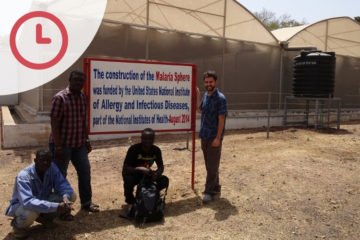Podcast Available on iTunes and Spotify.
Hello,
Welcome back to Five Minutes, the podcast series where we speak to the most interesting people in the world of malaria.
Today we’re joined by a representative from the PMI Vector Link Project. The project is equipping countries to plan and implement sustainable Indoor Residual Spraying programs and other life-saving malaria control interventions.
PMI stands for the President’s Malaria Initiative and was established in 2005. The organisation works alongside USAID and other aid organisations to try and reduce malaria transmission.
Thirteen years on, I wanted to know what’s changed in the malaria field and what they are currently doing to end malaria.
Remember that this podcast is available everywhere, it’s on Google Podcasts, Stitcher, Pocket Casts and Spotify. You can subscribe to the podcast online at fightmalaria.uk/FiveMinutes
This is Five Minutes with the PMI Vector Link Project.
Give us a short overview of what your role is within PMI Vector Link Project
As an entomologist on the President’s Malaria Initiative (PMI) VectorLink Project, I lead the entomological surveillance work and the capacity building effort for that work. I participate in various program monitoring and operational research activities designed to generate evidence that informs our vector control interventions. I also contribute to various publications on behalf of the project and share program data at international conferences like ASTMH and MIM. One other important aspect of my work on this project is building professional relationships with global malaria stakeholders to share knowledge, data and best practices in entomological monitoring.
Briefly give us a taste of the work carried out by the PMI Vector Link Project
The PMI VectorLink Project is a follow-on to the PMI Africa Indoor Residual Spray (AIRS) Project. The PMI VectorLink Project is an integrated vector control project that spans 24 countries. The focus of the project is on the planning, implementation, and monitoring of Indoor Residual Spraying (IRS) to combat malaria transmission and enhanced entomological monitoring to inform vector control interventions. Other key areas of the project include monitoring and evaluation of IRS and Insecticide Treated Nets (ITNs), environmental compliance, procurement and logistics, and gender.
Q: What, in your opinion, is the most effective way to prevent malaria?
There are five proven and cost-effective interventions that are currently available for use to reduce malaria morbidity and mortality. These are:
- Insecticide-treated nets (ITNs),
- Indoor residual spraying (IRS),
- Intermittent preventive treatment for pregnant women (IPTp),
- Seasonal malaria chemoprevention (SMC), and
- Effective case management (i.e., rapid diagnosis and treatment for confirmed cases with artemisinin-based combination therapies).
One or more of these proven interventions could be deployed to reduce deaths due to malaria.
As insecticide resistance grows, what strategies do you have in place to ensure that the US work carried out overseas is still effective?
The first step to insecticide resistance management is establishing a comprehensive and regular insecticide resistance monitoring in place to continuously get data on the evolution/ dynamics of insecticide resistance.
Insecticide resistance management approaches have been used in Agriculture and Public Health in the past. Several approaches have been used or proposed for managing resistance to insecticides for vector control, including rotations of insecticides, combination of interventions, mosaic spraying and use of mixtures.


